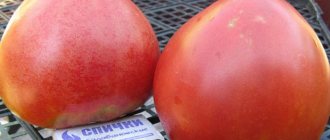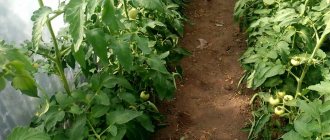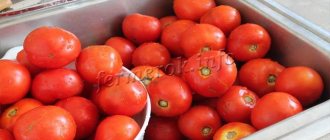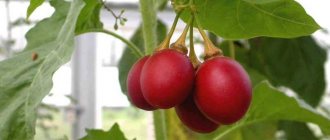History of variety development
This early-ripening variety with beautiful orange-yellow fruits was developed by Russian specialist Yu. I. Panchev in the last quarter of the last century. The Golden Heart tomato was tested at various experimental sites in the country, and in 2001 it was included in the Russian State Register of Agricultural Achievements.
Tomatoes of the Golden Heart variety are recommended to be grown in garden beds in open ground and in greenhouse conditions in most Russian regions
. But in areas with problematic farming, it is recommended to grow this tomato only indoors.
Photo of tomato Golden Heart
Tomato Golden Heart: variety description
This tomato variety is determinate, so its stems are limited in growth - when grown in open ground they have a height of only 0.8 m, but in a greenhouse they can grow up to 1.2 m.
The Golden Heart tomato is an early ripening one - about 3.5 months pass from the moment of seed germination to the collection of ripe produce from the bushes.
The bushes are quite compact, with erect, medium-leafy shoots of medium thickness. The foliage is typically tomato, medium in size, elongated, with sharp ends and wavy edges, wrinkled, dark emerald in color.
Racemose inflorescences are formed on the shoots every two permanent leaves. Each of them produces up to 7 fruits.
Ripe tomatoes are shaped like a heart - voluminous at the top and tapering at the bottom.
On a note!
In garden beds, the weight of the fruit can reach 130-150 g, and in closed ground, vegetable growers harvest Golden Heart tomatoes weighing 300 g with good care.
The skin is dense, smooth, with characteristic ribbing at the base of the fruit, its color is orange with a yellow tint. The pulp of tomatoes is slightly compacted, fleshy with several seed chambers and an amount of seed material.
The taste of ripe tomato fruits Golden Heart is sweet with a slight sourness
. The collected fruits contain a large amount of carotene, and these tomatoes are recommended for food for allergy sufferers, as they are a hypoallergenic product.
The fruits are not prone to cracking, so they tolerate transportation well over any distance and have excellent shelf life.
Diseases and pests
The resistance of the Golden Heart tomato to the main diseases of vegetable crops from the nightshade family is average, so it is recommended to periodically treat the bushes of this tomato with copper-containing preparations.
If the foliage on the tomatoes begins to darken and curl, the bushes should be treated with any of the biological products (Fitosporin or another similar one). All affected plant parts are removed and immediately burned off-site.
Insect pests of the Golden Heart tomato can affect:
- thrips;
- aphid;
- spider mite;
- whitefly
You can fight them with folk remedies - treat the vegetative mass with ammonia, infusion of onion peels, or a decoction of celandine. If there are a lot of insects on tomato bushes, then you have to use solutions of insecticidal preparations for treatment.
To avoid damage to this vegetable crop by diseases and pests, the following measures must be taken:
- ventilate greenhouses after watering;
- fight weeds;
- water tomatoes strictly according to schedule;
- mulch the soil after watering with a layer of humus or peat.
Interesting article:
Use of birch tar in the garden and in the garden
Fruit storage
If you store tomatoes correctly, you can enjoy fresh, aromatic vegetables even in winter.
If you plan to store vegetables in the refrigerator for a short time, then simply wrap each tomato in paper, then place it in a wooden box or plastic tray, with the stem facing up. Place the box in the refrigerator or a cool, dark place where the air temperature fluctuates between 8-12°C.
Important! Do not store tomatoes next to other fresh produce.
You can store tomatoes in the freezer. To do this, the fruits are cut and packed in sealed bags. Frozen tomatoes are used to prepare hot first and second courses.
To preserve tomatoes for as long as possible, it is recommended to properly collect and prepare them:
- Tomatoes are removed from the bush until they are fully ripe, when the fruit is still greenish but has already reached the required size;
- Harvesting from the bush is carried out during the day in sunny weather and in the absence of dew;
- Tomatoes without cracks or damage to the skin are selected for storage;
- To disinfect tomatoes, wipe them with alcohol;
- tomatoes are placed in a rigid container with the stalk facing up, each row is lined with paper or each fruit is wrapped in paper separately;
- there should not be more than three layers of tomatoes in one container;
- every week the fruits in the container must be inspected and all rotting tomatoes must be discarded;
- A week before consumption, the tomatoes are brought into a warm room for ripening.
On a note! Tomatoes that suffered frost or were picked from the bush during a period when night temperatures dropped below +8°C will not be stored for long.
Advantages and disadvantages
The main advantages of the Golden Heart variety include:
- early ripening of tomatoes;
- good yield;
- compactness of plants;
- the harvested crop can be transported to different distances;
- green fruits can be ripened at home;
- tomatoes are stored in appropriate conditions for a long time;
- You can collect seed material from ripe fruits, since the Golden Heart tomato is not a hybrid.
The disadvantages of the Golden Heart tomato include average resistance to diseases and pest attacks, the need to form fruits and tie shoots to strong supports.
Reviews
Liliya I., Rostov region
I am a beginner gardener, this year I decided to grow my own “Golden Heart” tomato seedlings. I bought seeds from the store and planted them. The sprouts sprouted very well, almost all the seeds sprouted. I transplanted the seedlings into a film greenhouse with arches. There were a lot of ovaries, which couldn’t help but rejoice. The tomatoes ripened later than indicated on the package, but apparently this was due to not the most favorable weather conditions. The harvest was taken in August. The tomatoes grew surprisingly meaty and tasty. Next year I will grow this wonderful variety again.
Artem Z., Moscow region
The tomatoes are moderately firm, not watery. We didn't get sick with anything all summer. The taste seemed to me not rich enough, but I can’t call this a big drawback. A good variety for growing in the country. It forgives beginners many mistakes, as it is not too whimsical.
Basic rules for planting tomato Golden Heart
In most Russian regions, the Golden Heart tomato is grown only by seedlings, and only in the south of the country are the seeds of this tomato sown directly into garden beds if desired.
4 main rules for successfully growing tomatoes - video
Sowing seed material
Golden Heart tomato seeds should be planted for seedlings approximately two months before transplanting them to a permanent place. Seedlings are usually transplanted into the greenhouse in late April - early May, so seeds can be planted for seedlings already in the last days of February.
Adult seedlings are transplanted into beds in the garden after the threat of spring frosts has passed - no earlier than the third ten days of May, so Golden Heart seed material should be planted for seedlings from about mid-March.
For planting, you can purchase ready-made soil in specialized garden stores, or you can prepare it yourself at home.
To do this you need to mix the following components:
- turf;
- humus;
- high-moor peat (or sawdust) to loosen the soil mixture.
After preparing such a nutrient substrate, it is disinfected by spilling it with a pink solution of potassium permanganate.
Purchased seeds do not require special preparation before sowing; they can only be placed in a solution of a growth stimulator for germination.
Prepared seeds from your own beds are first checked for germination; to do this, they are placed in salt water and only those that sink to the bottom of the plate are left for sowing. They are taken out of the solution, washed and dipped for half an hour in a weak solution of potassium permanganate for disinfection. Then they are washed again, dried and planted in pre-prepared containers.
Important!
After planting, water the soil and cover with plastic wrap. Until the sprouts appear, keep the containers in a warm, bright place. Seeds usually germinate within 6-8 days.
In the future, the seedlings need to be constantly watered, planted in separate cups at the stage of a pair of permanent leaves, fed twice with nitrogen fertilizers, and hardening off of the plants must begin 10-12 days before transplanting.
Preparing beds for planting seedlings
In greenhouses and garden beds in the autumn, organic fertilizers should be added for digging - humus or compost and wood ash. For each square of area you need to add at least 5-6 kg of organic matter and 200 g of ash.
In a greenhouse, it is advisable to completely replace the top layer of soil to a depth of 1 spade, or spill the old one with a weak solution of potassium permanganate for disinfection.
In spring, complex mineral fertilizer is additionally applied to the soil before planting tomato seedlings.
The area where it is planned to grow the Golden Heart tomato variety should be illuminated by the sun during the day and protected from gusts of cold wind. Also, when choosing such a site, you should follow the rules of crop rotation. This vegetable plant should not be planted after other plants from the nightshade family.
The best predecessors for the Golden Heart tomato are the following crops:
- cabbage;
- carrot;
- onion;
- beans;
- peas;
- soybeans
Transplanting seedlings to a permanent place
No more than 4 plants should be planted on one square
. When planting tomatoes in beds, planting holes are dug at a distance of 0.3 m from each other.
Plants are planted in holes by transferring them together with a clod of earth. Then soil is added to the holes, compacted and watered. At least 4 liters of warm water should be poured under each Golden Heart tomato bush.
Caring for seedlings after planting in open ground
To obtain a good harvest, tomatoes planted in the ground require systematic care.
Irrigation
Despite its good resistance to short periods of drought, the Golden Heart tomato requires regular, abundant watering.
After planting, moisture is added for the first time 10 days later. Then, in dry weather, watering is practiced in the morning or evening every six days, pouring 4-5 liters of settled water under each plant. Avoid getting drops on the leaf plates.
When mass formation of fruits begins, the intervals between waterings are reduced to three days.
Top dressing
During the growing season, Golden Heart tomatoes require fertilizer. It is advisable to pour under each bush, without touching the leaves, a liter of the prepared liquid nutrient solution. Follow the following sequence of procedures:
- 14 days after the Golden Heart tomato seedlings are moved into the ground, urea is added. In a 20-liter container dilute 2 tbsp. l. fertilizers
- A week later, the tomatoes are fed with liquid chicken droppings. A liter jar of organic matter is mixed in 20 liters of water.
- When inflorescences appear, grooves are formed around the plants, which are filled with ash and sprinkled with soil.
- When 3-4 brushes open, it is time to add potassium humate, a tablespoon of which is dissolved in a container with 10 liters of settled water.
- At the stage of fruit ripening, the plantings are irrigated with a superphosphate solution prepared from 2 tbsp. l. fertilizers and 20 liters of water warmed in the sun.
See also Tomato variety Cosmonaut Volkov: yield and cultivation characteristics
Bush formation
A feature of the Golden Heart tomatoes is the rapid formation of lateral stems with an overall low bush height.
It is recommended to form it into 2-3 stems, breaking out the stepsons in a timely manner. If seed fruits are required, they are taken from the second cluster.
As the plant grows, it is tied up by driving a strong peg nearby. This will avoid the risk of stems breaking due to fruits gaining weight.
Mulching the soil, removing weeds
After watering and loosening the soil, it is recommended to cover the surface under the tomato bushes with a layer of mulch, using hay, chopped straw, and dry sawdust.
Be sure to remove weeds that can worsen the condition of tomato bushes, extracting moisture and necessary nutrients from the soil.
Protection from diseases and insects
In order to prevent fungal infections, the lower leaves are torn off from tomato bushes as they grow.
For prevention, special formulations are prepared, which are used to irrigate the Golden Heart tomato plantings every 6-7 days. You can use baking soda - 2 tbsp. l. Dissolve the substance in 10 liters of water warmed under the sun's rays. Iodine solution helps a lot. For 20 liters of water take 20 drops of the drug. Ready-made drugs such as “Gamair”, “Epin”, “Fitosporin”, “Alerin” are considered good preventive agents.
At the first signs of disease development (brown spot, blossom end rot, macrosporiosis, late blight), fungicidal solutions are used. “Oxychom”, “Barrier”, “Barrier” work effectively.
Of the pests, whitefly causes significant damage to tomato bushes, and Citcor and Fosbecid are used to combat it. The appearance of the Colorado potato beetle can reduce the yield. To remove the larvae of this pest, tomato bushes are irrigated with a solution of the preparations “Decis” and “Dilor”.
Tomato Golden Heart: reviews from those who planted the variety
Olga, 30 years old, Yekaterinburg: I regularly buy vegetable seeds for my parents in stores. Last year I bought a bag of Golden Heart tomato seeds to try. As a result, 25 seedlings sprouted, which were planted in a garden bed in open ground, watered and fed according to the rules. As a result, about 3 kg of fairly large tomatoes were collected from each bush. Most of the harvest was eaten fresh, and some of it was stored away for the winter to make delicious yellow tomato juice.
Irene, 45 years old, Moscow region: I grow the Golden Heart variety in seedlings, and after a couple of months I transplant it into a greenhouse. In it, bushes grow more than a meter, and tomatoes can weigh more than 300 g. The harvested crop was used for food, as well as for twists for the winter. The Golden Heart is also great.
Natalya, 50 years old, Abakan: I planted this tomato variety in open ground and in a greenhouse at the same time, then compared the results. And I can say that, of course, this variety grows better indoors and produces a significantly higher yield. However, it is advisable to process the collected fruits faster.
This tomato variety is distinguished by good yield, beautiful appearance of the fruits and their original color, and ease of care.
That is why the Golden Heart tomato is so loved by Russian vegetable growers.











